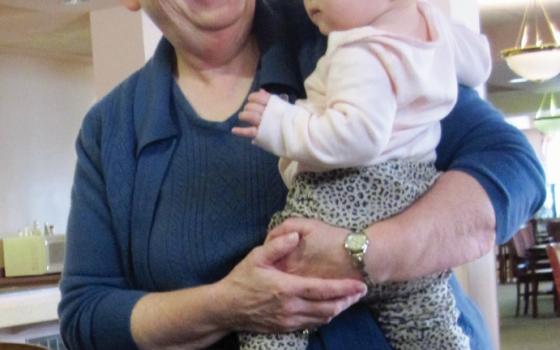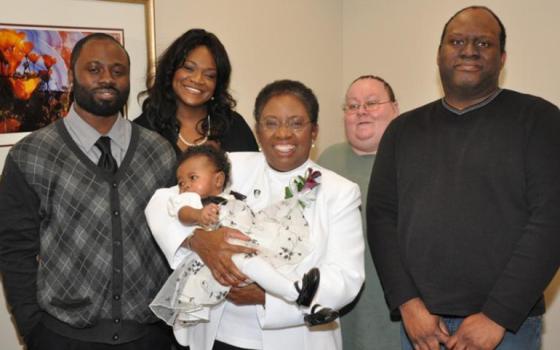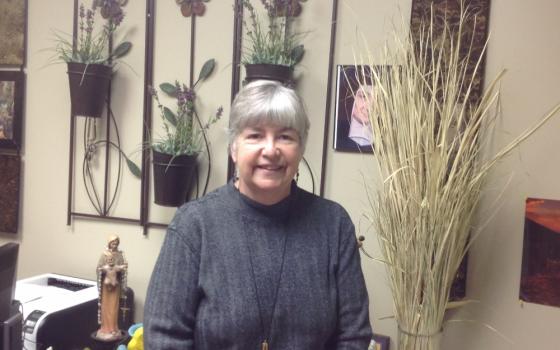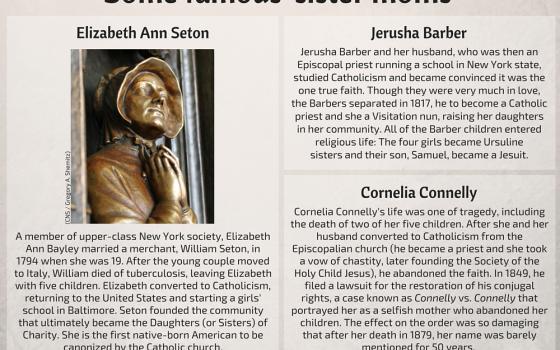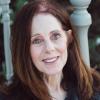The way Sr. Rita Cameron sees it, her grandchildren didn't lose a grandmother when she became a sister. They gained 106 great-aunts.
"Everybody loves them," said Cameron, who is vocations director for the Sisters of the Presentation of the Blessed Virgin Mary in Dubuque, Iowa.
Cameron is part of a relatively small but significant segment of women entering religious life having grown children and, occasionally, grandchildren.
Notre Dame de Namur Sr. Mary Johnson, a sociologist at Trinity Washington University, found in a 1999 study of sisters who had entered religious life since the end of the Second Vatican Council that of the 2,740 women who responded, 3 percent reported having been divorced (and their marriages annulled) before entrance, and 1 percent had been widowed. Four percent had children.
Ten years later, a survey undertaken by the Center for Applied Research in the Apostolate and the National Religious Vocation Conference found that of 985 female respondents who had entered religious life in the previous 20 years, 10 percent said they had been previously married, and 7 percent had children.
"We are not talking about a huge phenomenon," Johnson told Global Sisters Report. "We are talking about a small but significant phenomenon that does bring some women who have different life experiences to religious orders."
As these women undergo a distinct change of life, they bring with them not only a prior marital history but ongoing responsibilities as parents. (Women with younger children must wait to become sisters until their children are independent.) The mothers interviewed for this story were clear that they would not have considered religious life if it had come between them and their children.
The Catholic church places a high value on parenthood as a vocation. But the entrance of previously married women into religious communities also raises another possibility: more than one sacred calling.
Johnson said this particular phenomenon, while not new, is another sign of increasing diversity in the "very dynamic reality" of Catholic religious life.
"All of these diversities will impact our local community living, our communal prayer life, our decision-making processes, our governance structures within congregations and, of course, our ministries," she said.
The stories of how these women were drawn to religious life are as diverse as the women themselves.
Cameron had been a public school music teacher and then a guidance counselor before her husband died.
"If he had lived, I'd be a happily married woman today," she said.
When she met the Presentation of the Blessed Virgin Mary Sisters after taking a guidance position in a parochial school in Mason City, she found a new purpose in life.
"I had so much fun. Their prayer was so rich," she said. "Spending time with them showed me that this was what I was looking for."
At the time, her son was in his early 20s.
"How do I tell my friends my mom is a nun?" Cameron said he asked.
"I was happy for her," said JoAnn Csapos, Cameron's daughter. "Growing up, she allowed me the opportunity to do different things, like the 4-H Club and an exchange program in Switzerland. She was lovely with me; it was time for her to try things in her own life and go for it."
For some women, renewed faith can open the door to new vocational possibilities.
As a young married mother raising small children, Patricia Dual, now a Dominican Sister of Peace, walked away from the Catholic church for about 11 years. But as her relationship with her husband frayed, "I came back at a low point in my life. I guess I was feeling that my life as defined had to change."
Her return to the church, particularly ties to her local parish, enabled her to build a network of support that ultimately helped her leave the turbulent marriage.
"God brought people into my life to help me heal emotionally," she said.
Around 1995, Dual met Pat Twohill, a St. Mary of the Spring Dominican, when they worked together on the pastoral council for the diocese of Richmond, Virginia, and began to ask questions about Twohill's order.
In one of her many conversations with her new friend, Dual asked: Do you have any African-American sisters in your congregation?
"No," Dual said Twohill told her with a laugh, "but you could be the first."
"A seed was planted," Dual said. "I did begin to think about it off and on" for the next five years."
After attending a National Black Sisters conference in 2002 and meeting a "sister mom" already on the road to religious life, Dual launched the process that would take her from Norfolk, Virginia, to Columbus, Ohio, in 2005, when she entered formation as a member of the Dominican Sisters St. Mary of the Spring (now part of the Dominican Sisters of Peace).
While there are many sisters who have had children, each woman's experience is different, Dual said.
"What's common is that the community embraces the sisters and the family," she said. "It's not like [the family] has lost a mom. It's like they have a lot of adopted moms."
When a marriage ends, it can sometimes prompt soul-searching as well as pain.
Until she got divorced, Linda Mershon said she thought her marriage was her vocation.
In the early 1990s, Mershon, now a Franciscan Sister of Perpetual Adoration based in La Crosse, Wisconsin, was living in Arizona, working toward a master's degree in spirituality, and praying for guidance about her future path.
"I had to begin over again and say, 'This is no longer it. What is it you want me to do in this world?'" she said.
Her quest led to her to a month's practicum experience in Mexico sponsored by the Franciscan Sisters of Perpetual Adoration. During that month, she said, one of the two sisters she lived with asked her if she might consider religious life, assuring her that the congregation was open to previously married women.
"It hadn't really occurred to me before," Mershon said.
Two years later, her youngest child ensconced in college, she applied for entrance to the La Crosse community. She made her first vows in 1998 and her final ones in 2001, and she was elected to a position in congregational leadership in 2006.
Mershon's son, Joe, was 20 years old and in the Navy when his mother made the decision to enter religious life. Though he still relishes surprising new friends with the news that his mother is a nun, he said he wasn't surprised at her decision.
"It felt like a natural progression," he said.
For one woman, the path to new life in community came through searing loss.
Notre Dame de Namur Sr. Nancy Uhl advises the parishioners at the Covina, California, church where she is a pastoral counselor not to grieve the way she did for her late husband, Chuck Sheehan.
"I was in a dark place for years," she said. "I think that the only way God could talk to me was to take that unbearable grief."
Yet at the same time, she said she felt a great and unnamable longing. Fearing it was mental illness, she consulted a therapist and her spiritual director.
"Both came to the conclusion that this was a true call. I had to consider it," she said.
At that point, Uhl was over 50 with a teenage daughter. "Nobody wanted me," she said. "I'm like the worst possible candidate. I'm too old and my kid is too young."
Her daughter, Sarah Sheehan Adkison, was 15 when her mother shared the news of her new direction with her. Though the idea was a little jarring at first, Sheehan Adkison said, she was aware of how important faith had been to her parents, and it made sense that her mother would try to develop a life she could own in the wake of her loss.
"When you enter religious life, you can no longer take care of your child," Uhl said. "That is the hardest thing about being a mother and a religious woman. If your children are in trouble, you want to help them. At least financially, I can't do that. "
But family ties still remain central to her life, including time to text her daughter's stepdaughter, "who absolutely adores her," Sheehan Adkison said.
"She's a phenomenal inspiration to so many people," said Sheehan Adkinson, who watched Uhl take final vows in February. "One lesson she instilled in me is that there is no higher purpose than a life of service."
There are practical considerations, including financial ones, for women entering religious life with children and grandchildren.
Even before she made the decision to pursue religious life, Dual said she found herself making financial decisions that would open the door to a life change, including paying off her debts and making sure her two sons were financially secure.
Cameron gave her South Dakota property to her children, along with her cash and investments; sold her house; and donated her car, cash and investments to her children, she said. Her teacher retirement pension accompanied her into her community.
Before Uhl entered her community, she had to divest herself of any assets or turn them over to the order, she said. Since her only asset was her home, she sold that and used the proceeds for her daughter's education, she said.
"We didn't have much in the way of assets," she said. "We'd only owned the home for seven years. My retirement got pretty much decimated by the stock market, so Sarah inherited my poverty!"
Uhl said older women whose personalities and communication skills were formed in the secular world may bring a different perspective into religious communities. Yet those different outlooks can enhance community life, she said: Her community includes a former pharmacist, nurses, a social worker, a therapist, and the vice president of a prestigious company.
"These women were really successful, but it wasn't what they were looking for," Uhl said.
Mershon demurs when asked if her life as a sister is a calling. "I feel that every human being is called by God to be their true self," she said.
"I don't know about 'call.' I know that God was involved in presenting me the opportunity to make this choice."
[Elizabeth Eisenstadt Evans is a religion columnist for Lancaster Newspapers, Inc., as well as a freelance writer.]
